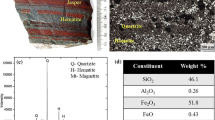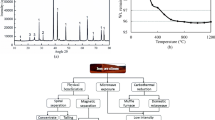Abstract
The current study investigates the effect of microwave processing on low-grade banded iron ore using charcoal, coking coal, and non-coking coal. Charcoal showed better microwave heating response at low temperatures, and the coals exhibit better heating response at higher temperatures. Low carbon dosage ~ 12% is sufficient to generate concentrate with 61.8% iron grade and ~6% for 94.8% iron recovery comprising of magnetite phase suitable for iron-making applications. The process separation efficiency of ~ 95% is achieved at 6% carbon dosage and decreases with an increase in carbon due to formation of the fayalite phase. The metallization degree showed a strong dependency on reductant dosage and achieved a maximum value of 22.7% at 18% charcoal. The comparison of ore with pure iron oxide and the synthetic mixture of iron oxide indicated that the underlying bonding due to banded structure enhances the Joule heating during microwave irradiation and thereby aids in attaining higher temperature and better separation.












Similar content being viewed by others
References
Rayapudi V, Agrawal S, Dhawan N (2019) Optimization of microwave carbothermal reduction for processing of banded hematite jasper ore. Min Eng 132:202–210
Hara K, Hayashi M (2011) Continuous pig iron making by microwave heating with 12.5 kW at 2.45 GHz. J Microw Power Electromagn Energy 45:137–147
Hayashi M, Takeda K, Kashimura K, Watanabe T, Nagata K (2013) Carbothermic reduction of hematite powders by microwave heating. ISIJ Int 53:1125–1130
Pickles CA (2009) Microwaves in extractive metallurgy: part 2–a review of applications. Min Eng 22(13):1112–1118
Zhou J, Xu W, You Z, Wang Z, Luo Y, Gao L, Lan L (2016) A new type of power energy for accelerating chemical reactions: the nature of a microwave-driving force for accelerating chemical reactions. Sci Rep 6:25149
Hunt J, Ferrari A, Lita A, Crosswhite M, Ashley B, Stiegman AE (2013) Microwave-specific enhancement of the carbon–carbon dioxide (Boudouard) reaction. J Phys Chem C 117(51):26871–26880
Stir M, Ishizaki K, Vaucher S, Nicula R (2009) Mechanism and kinetics of the reduction of magnetite to iron during heating in a microwave E-field maximum. J Appl Phys 105:124901
Standish N, Huang W (1991) Microwave application in carbothermic reduction of iron ores. ISIJ Int 31(3):241–245
Kashimura K, Nagata K, Sato M (2010) Concept of furnace for metal refining by microwave heating -a design of microwave smelting furnace with low CO2 emission. Mater Trans 51:1847–1853
Amini A, Ohno KI, Maeda T, Kunitomo K (2018) Effect of the ratio of magnetite particle size to microwave penetration depth on reduction reaction behaviour by H2. Sci Rep 8(1):1–7
Barani K, Koleini SJ, Rezaei B (2011) Magnetic properties of an iron ore sample after microwave heating. Separ Purif Technol 76(3):331–336
Rayapudi V, Dhawan N (2020) Evaluation of carbothermal reduction for processing of banded hematite quartzite iron ore. Can Metall Q 59(2):125–133
Agrawal S, Dhawan N (2020) Microwave carbothermic reduction of low-grade iron ore. Metall Mater Trans B Process Metall Mater Process Sci 51:1576–1586. https://doi.org/10.1007/s11663-020-01883-z
Wills BA, Finch J (2015) Wills’ mineral processing technology: an introduction to the practical aspects of ore treatment and mineral recovery. Butterworth-Heinemann
Han H, Duan D, Yuan P, Chen S (2015) Recovery of metallic iron from high phosphorus oolitic hematite by carbothermic reduction and magnetic separation. Ironmak Steelmak 42(7):542–547
Harrison PC (1997) A fundamental study of the heating effect of 2.45 GHz microwave radiation on minerals. Dissertation, University of Birmingham
Williams O, Ure A, Stevens L, Binner E, Dodds C, Kingman S, Das B, Dash PS, Lester E (2019) Formation of metallurgical coke within minutes through coal densification and microwave energy. Energy Fuel 33(7):6817–6828
Lester E, Kingman S, Dodds C, Patrick J (2006) The potential for rapid coke making using microwave energy. Fuel. 85:2057–2063
Huang J, Xu G, Liang Y, Hu G, Chang P (2020) Improving coal permeability using microwave heating technology—a review. Fuel 266:117022. https://doi.org/10.1016/j.fuel.2020.117022
Mishra S, Roy GG (2016) Effect of amount of carbon on the reduction efficiency of iron ore-coal composite pellets in multi-layer bed rotary hearth furnace (RHF). Metall Mater Trans 47(4):2347–2356
Agrawal S, Rayapudi V, Dhawan N (2019) Comparison of microwave and conventional carbothermal reduction of red mud for recovery of iron values. Miner Eng 132:202–210
Whittaker G (1997) A basic introduction to microwave chemistry. Accessed, 1(02), 20
Funding
The authors acknowledge the Science Engineering Research Board for providing financial assistance via Early career research Grant (ECR/874/2016).
Author information
Authors and Affiliations
Corresponding author
Ethics declarations
Conflict of Interest
The authors declare that they have no conflict of interest.
Additional information
Publisher’s Note
Springer Nature remains neutral with regard to jurisdictional claims in published maps and institutional affiliations.
Rights and permissions
About this article
Cite this article
Agrawal, S., Mir, S. & Dhawan, N. Microwave Processing of Low-Grade Banded Iron Ore with Different Reductants. Mining, Metallurgy & Exploration 38, 151–160 (2021). https://doi.org/10.1007/s42461-020-00304-8
Received:
Accepted:
Published:
Issue Date:
DOI: https://doi.org/10.1007/s42461-020-00304-8




